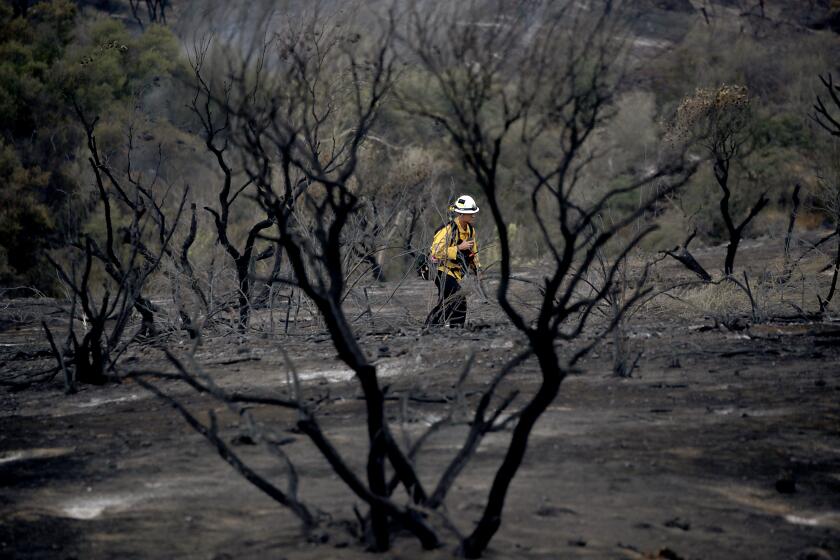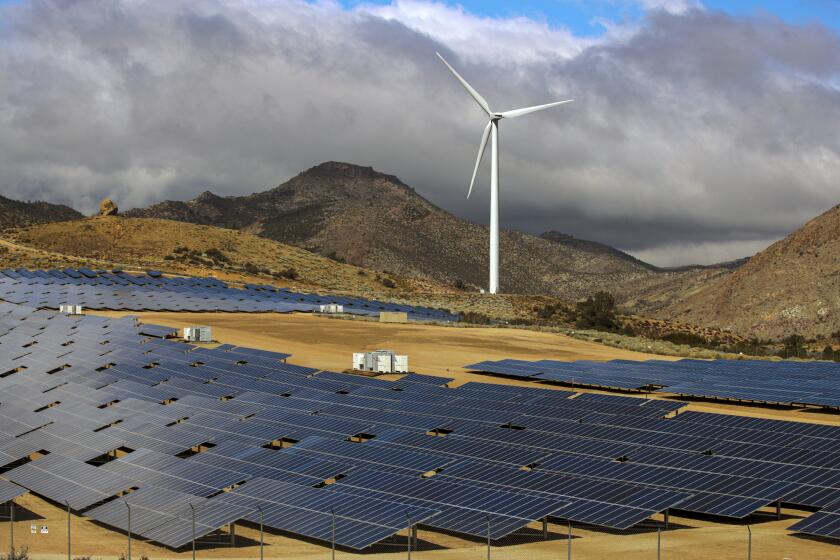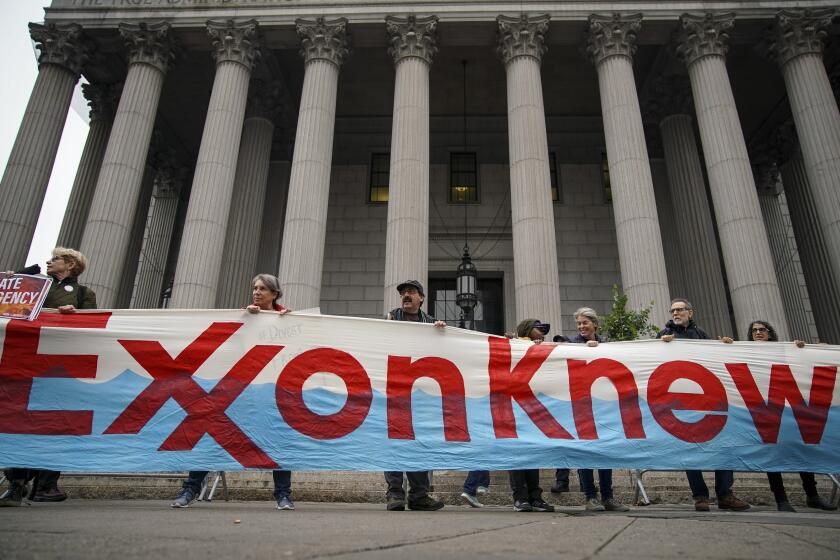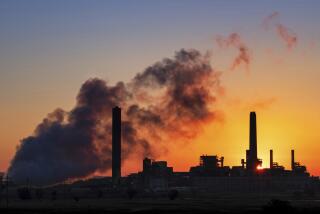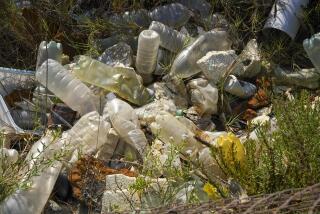EPA says pollution limits proposed for U.S. coal, gas power plants reflect climate crisis ‘urgency’
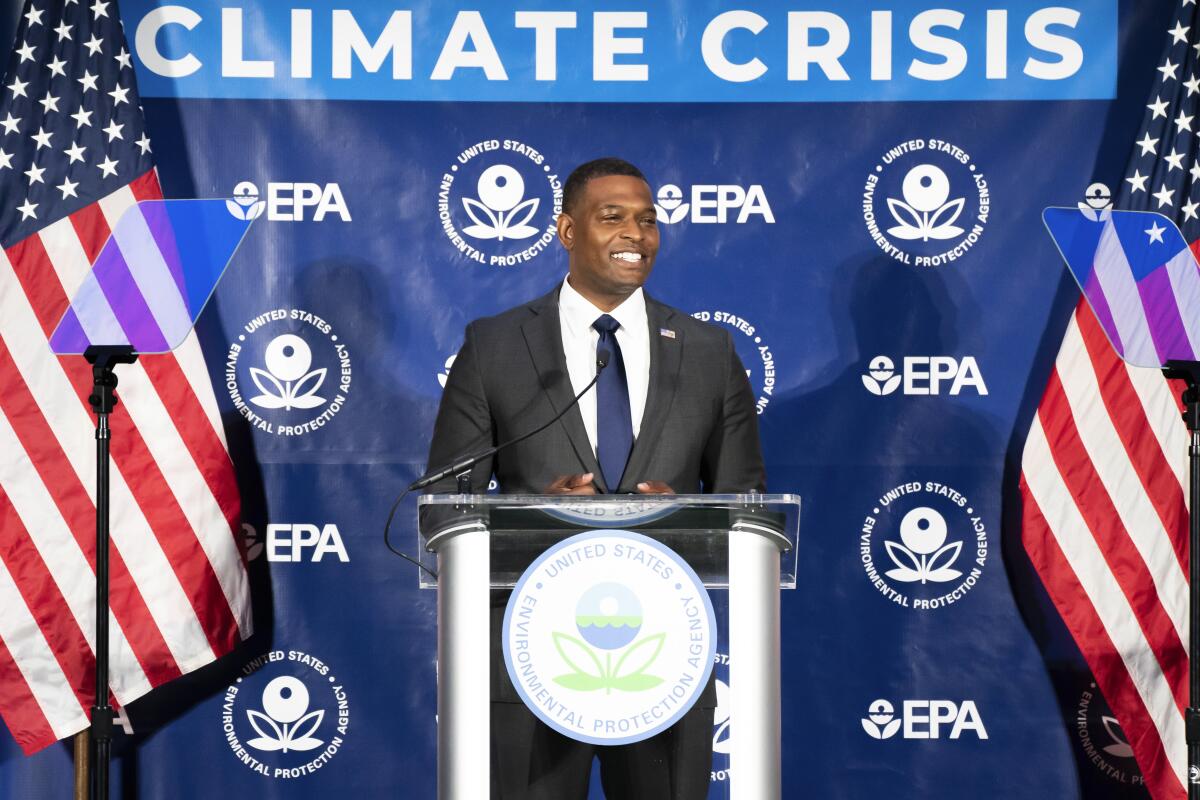
- Share via
WASHINGTON — The Biden administration proposed new limits Thursday on greenhouse gas emissions from coal- and gas-fired power plants, its most ambitious effort yet to roll back planet-warming pollution from the nation’s second-largest contributor to climate change.
A rule announced by the Environmental Protection Agency could force power plants to capture smokestack emissions with a technology that has long been promised but is not used widely in the United States.
“This administration is committed to meeting the urgency of the climate crisis and taking the necessary actions required,” EPA Administrator Michael S. Regan said.
The plan would not only “improve air quality nationwide, but it will bring substantial health benefits to communities all across the country, especially our front-line communities ... that have unjustly borne the burden of pollution for decades,” Regan said in a speech at the University of Maryland.
President Biden called the plan “a major step forward in the climate crisis and protecting public health.”
If finalized, the regulation would mark the first time the federal government has restricted carbon dioxide emissions from existing power plants, which generate about 25% of U.S. greenhouse gas pollution, second only to the transportation sector.
The rule also would apply to future electric plants and would avoid up to 617 million metric tons of carbon dioxide through 2042, equivalent to annual emissions of 137 million passenger vehicles, the EPA said.
Almost all coal plants — along with large, frequently used gas-fired power plants — would have to cut or capture nearly all their carbon dioxide emissions by 2038, the EPA said. Plants that cannot meet the new standards would be forced to retire.
The state report paints a stark picture of California’s escalating climate crisis and documents wide-ranging effects on weather, water and residents.
Industry groups and Republican-leaning states are likely to challenge the plan. They have accused the Democratic administration of overreach on environmental regulations and warn of a pending reliability crisis for the electric grid. The power plant rule is one of at least a half-dozen EPA rules limiting power plant emissions and wastewater treatment.
“It’s truly an onslaught” of government regulation “designed to shut down the coal fleet prematurely,” said Rich Nolan, president and chief executive of the National Mining Assn.
Regan denied that the power plant rule was aimed at shutting down the coal sector but acknowledged, “We will see some coal retirements.”
The proposal “relies on proven, readily available technologies to limit carbon pollution” and builds on industry practices already underway to move toward clean energy, he said.
Coal provides about 20% of U.S. electricity, down from about 45% in 2010. Natural gas provides about 40% of U.S. electricity. The remainder comes from nuclear energy and renewables such as wind, solar and hydropower.
Building renewable power on public lands could help solve the climate crisis. But projects are often controversial.
Environmental groups hailed the EPA’s action as urgently needed to protect against devastating harms of climate change, including increasingly severe flooding, hurricanes and drought, and worsening wildfires.
Fred Krupp, president of the Environmental Defense Fund, said the proposal “will bring us closer to a clean energy future with healthier air, a safer climate, good jobs and affordable, reliable electricity.”
Jim Matheson, CEO of the National Rural Electric Cooperative Assn., said the plan would further strain America’s electric grid and “undermine decades of work to reliably keep the lights on across the nation.”
Matheson, whose association represents 900 local electric cooperatives across the country, said EPA’s plan could “force critical, always-available power plants into early retirement, and make new natural gas plants exceedingly difficult to permit, site and build.”
The EPA rule would not mandate use of equipment to capture and store carbon emissions — a technology being developed. Instead, the agency would set caps on carbon dioxide pollution that plant operators would have to meet. Some natural gas plants could start blending gas with another fuel source such as hydrogen, which does not emit carbon, although specific actions would be left to the industry.
Still, the regulation is expected to lead to greater use of carbon capture equipment, a technology that the EPA said has been “adequately demonstrated” to control pollution. Only a handful of projects are operating in the country despite years of research.
Jessie Stolark, executive director the Carbon Capture Coalition, said the proposed rules “elevate the role of carbon capture by naming it as one of the available technologies for reaching emissions standards.” Even with aggressive growth of renewables over the next decade, fossil fuels, especially natural gas, “will be in the domestic energy mix for decades,” said Stolark, whose coalition includes industry, labor and environmental groups.
Groups on both ends of the political spectrum questioned whether carbon capture and storage is a realistic solution.
“Billions of dollars have been wasted trying to prove that this technology is real — and all we have to show for it are a series of spectacular failures,” said Wenonah Hauter, executive director of Food & Water Watch, a left-leaning advocacy group.
Marty Durbin, president of the U.S. Chamber’s Global Energy Institute, said EPA regulations “must be grounded in what is technologically feasible and commercially available. Going beyond that, as this regulation does, could threaten electric reliability and raise energy prices to unsustainable levels.”
About 60% of the electricity generated in the nation last year came from the nation’s 3,400 coal- and gas-fired plants, according to the U.S. Energy Information Administration.
“We need to do this to meet the climate crisis,” said David Doniger, senior strategic director for climate and clean energy at the Natural Resources Defense Council.
The power plant rules are crucial to meeting Biden’s goals to cut greenhouse gas emissions in half by 2030 and eliminate carbon emissions from the power grid by 2035, he and other advocates said.
President Biden is hosting a virtual global summit on Thursday and Friday to mark the United States’ return to the fight against climate change.
The proposal comes weeks after the administration announced strict new tailpipe pollution limits that would require up to two-thirds of new vehicles sold in the U.S. to be electric by 2032 and months after Biden announced rules to curb methane leaks from oil and gas wells.
The rules follow climate action by the 2021 infrastructure law and billions of dollars in tax credits and other incentives from the Inflation Reduction Act, approved last year.
While Biden has made fighting global warming a top priority, he has faced sharp criticism from environmentalists — particularly young climate activists — for a recent decision to approve the contentious Willow oil project in Alaska. The massive drilling plan by oil giant ConocoPhillips could produce up to 180,000 barrels of oil a day on Alaska’s petroleum-rich North Slope. Environmental groups call Willow a “carbon bomb” and have mounted a social media #StopWillow campaign.
Internal research by Exxon Mobil accurately predicted global warming due to the burning of fossil fuels, yet publicly denied the connection.
The new plan comes 14 years after the EPA declared that carbon dioxide and other greenhouse gases endanger public health. President Obama tried to set limits on carbon pollution from U.S. power plants, but his 2015 Clean Power Plan was blocked by the Supreme Court and later was rolled back by President Trump.
Last year, the Supreme Court limited how the Clean Air Act can be used to reduce climate-altering emissions from power plants. The 6-3 ruling confirmed the EPA’s authority to regulate carbon emissions from power plants but said it could not force a nationwide transition away from the use of coal to generate electricity.
Vickie Patton, general counsel at the Environmental Defense Fund, said the rule relies on EPA’s traditional authority to regulate air pollution and is “consistent with the language in the majority opinion” by Chief Justice John G. Roberts Jr. “What you see here is a proposal that takes great care to address the Supreme Court’s concerns,” she said.
The EPA said its new rule will give plant operators flexibility to meet the new standards in a method of their choosing. And instead of creating one limit that all power plants must meet, the agency said, it will set a range of targets based on the size of the plant, how often it is used and whether it is already scheduled for retirement.
More to Read
Toward a more sustainable California
Get Boiling Point, our newsletter exploring climate change, energy and the environment, and become part of the conversation — and the solution.
You may occasionally receive promotional content from the Los Angeles Times.
